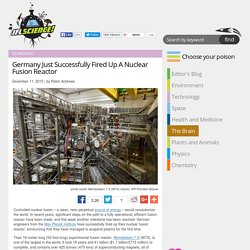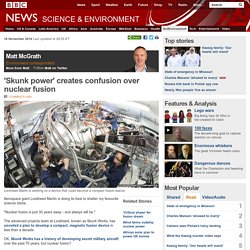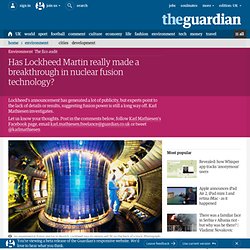

Germany Just Successfully Fired Up A Nuclear Fusion Reactor. Controlled nuclear fusion – a clean, near-perpetual source of energy – would revolutionize the world.

In recent years, significant steps on the path to a fully operational, efficient fusion reactor have been made, and this week another milestone has been reached: German engineers from the Max Planck Institute have successfully fired up their nuclear fusion reactor, announcing that they have managed to suspend plasma for the first time. Their 16-meter-long (52-foot-long) experimental fusion reactor, Wendelstein 7-X (W7X), is one of the largest in the world. It took 19 years and €1 billion ($1.1 billion/£715 million) to complete, and contains over 425 tonnes (470 tons) of superconducting magnets, all of which need to be cooled to absolute zero. Within it, the process that operates at the heart of stars can hypothetically take place.
The first suspended plasma within the W7X reactor. 'Skunk power' creates confusion over nuclear fusion. 16 November 2014Last updated at 20:53 ET.

Michio Kaku: Fusion Really Is 20 Years Away. Www.cap.ca/sites/cap.ca/files/article/1700/oct10-opinion-vogt.pdf. NASA’s cold fusion tech could put a nuclear reactor in every home, car, and plane. The cold fusion dream lives on: NASA is developing cheap, clean, low-energy nuclear reaction (LENR) technology that could eventually see cars, planes, and homes powered by small, safe nuclear reactors.

When we think of nuclear power, there are usually just two options: fission and fusion. Fission, which creates huge amounts of heat by splitting larger atoms into smaller atoms, is what currently powers every nuclear reactor on Earth. Fusion is the opposite, creating vast amounts of energy by fusing atoms of hydrogen together, but we’re still many years away from large-scale, commercial fusion reactors. (See: 500MW from half a gram of hydrogen: The hunt for fusion power heats up.) LENR is absolutely nothing like either fission or fusion. The key to LENR’s cleanliness and safety seems to be the slow-moving neutrons. According to NASA, 1% of the world’s nickel production could meet the world’s energy needs, at a quarter of the cost of coal. So why don’t we have LENR reactors yet? Solve for X: Charles Chase on energy for everyone. High Hopes – Can Compact Fusion Unlock New Power For Space And Air Transport? The announcement by Lockheed Martin’s Skunk Works of plans to develop a compact fusion reactor (CFR) has potentially huge implications for future space and aircraft propulsion.

Should the current round of experiments prove out the viability of the physics, then the scale, safety, and power of the concept means that CFRs could one day be used to power space craft on deep-space missions to Mars. They might also be small enough to power large transport and freighters of the future, converting thermal energy through heat exchangers to power turbines in place of combustion chambers. Here Tom McGuire, the inventor and leader of the Lockheed Martin CFR project, explains the basics of the concept. According to McGuire, when it comes to deep space exploration “the grand vision is we can get to Mars in a month, and you can only do that if you have a ton of power. So this is the type of power source you’d need to do that.
Skunk Works Reveals Compact Fusion Reactor Details. Hidden away in the secret depths of the Skunk Works, a Lockheed Martin research team has been working quietly on a nuclear energy concept they believe has the potential to meet, if not eventually decrease, the world’s insatiable demand for power.

Dubbed the compact fusion reactor (CFR), the device is conceptually safer, cleaner and more powerful than much larger, current nuclear systems that rely on fission, the process of splitting atoms to release energy. Crucially, by being “compact,” Lockheed believes its scalable concept will also be small and practical enough for applications ranging from interplanetary spacecraft and commercial ships to city power stations. It may even revive the concept of large, nuclear-powered aircraft that virtually never require refueling—ideas of which were largely abandoned more than 50 years ago because of the dangers and complexities involved with nuclear fission reactors. An initial production version could follow five years after that. Lockheed Martin's new fusion reactor can change humanity forever.
This is outstanding!!

From the military's point of view, you'd be able to run a carrier, or hell, any ship with this and dramatically reduce your fuel costs. If it's the size of a jet engine, they can put it on pretty much anything in the navy's fleet, or on a drone with unlimited flight time? Wow. Nuclear Fusion: 'This is the Adventure Part of Venture Capital' While eating lunch at a recent energy conference with the usual random selection of delegates and speakers, I asked the co-founder of a leading energy venture capital firm what technology he finds most exciting right now.

Without hesitation, he began telling me about his company’s ambitious, longer-term bet on a small nuclear fusion company. He then put me in contact with his partner and co-founder, who helped fill in the details for this story. The Boy Who Played With Fusion - Taylor Wilson at TEDxRedmond 2012. Fusion Energy Explained. How will a fusion power plant work? Steven Cowley: Fusion is energy's future. Has Lockheed Martin really made a breakthrough in nuclear fusion technology? Scientists have responded with scepticism to the announcement of a breakthrough in nuclear fusion by Lockheed Martin.

The arms manufacturer announced on Wednesday that it was “working on a new compact fusion reactor (CFR) that can be developed and deployed in as little as 10 years”. But Lockheed’s four paragraph press release and accompanying video are heavy on hyperbole and light on detail. Project leader Tom McGuire, whose company is the Pentagon’s largest supplier of armaments, says the project could usher in a new era of peace and energy security.
“As a defence company our increasing mission is to enhance global security and this is how we do that in the energy realm,” says McGuire. “The old promise of atoms for peace was a noble one, but ultimately flawed because the technology wasn’t right for it. But fusion researchers have responded coolly to the Lockheed announcement. Fusion reactor designed in hell makes its debut.